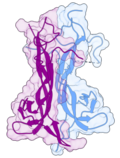receptor (also known as the NMDA receptor or NMDAR), is a glutamate receptor and predominantly Ca2+ ion channel found in neurons. The NMDA receptor is...
107 KB (12,058 words) - 11:59, 2 November 2024
NMDA receptor antagonists are a class of drugs that work to antagonize, or inhibit the action of, the N-Methyl-D-aspartate receptor (NMDAR). They are...
38 KB (4,196 words) - 12:46, 14 July 2024
Anti-NMDA receptor encephalitis is a type of brain inflammation caused by antibodies. Early symptoms may include fever, headache, and feeling tired. This...
35 KB (3,670 words) - 22:26, 3 October 2024
Olney's lesions (redirect from NMDA Receptor Antagonist Neurotoxicity)
Olney's lesions, also known as NMDA receptor antagonist neurotoxicity (NAT), is a form of brain damage consisting of selective death of neurons but not...
14 KB (1,859 words) - 06:35, 2 September 2024
N-Methyl-D-aspartic acid (redirect from NMDA)
acts at that receptor. Unlike glutamate, NMDA only binds to and regulates the NMDA receptor and has no effect on other glutamate receptors (such as those...
12 KB (988 words) - 20:01, 15 August 2024
Extrasynaptic NMDA receptors are glutamate-gated neurotransmitter receptors that are localized to non-synaptic sites on the neuronal cell surface. In...
6 KB (630 words) - 14:34, 22 November 2022
Ligand-gated ion channel (redirect from Ionotropic receptor)
acid receptor (also known as AMPA receptor, or quisqualate receptor) is a non-NMDA-type ionotropic transmembrane receptor for glutamate that...
29 KB (2,597 words) - 03:43, 7 April 2024
GRIN2B (redirect from NMDA receptor 2B)
Glutamate [NMDA] receptor subunit epsilon-2, also known as N-methyl D-aspartate receptor subtype 2B (NMDAR2B or NR2B), is a protein that in humans is...
16 KB (1,905 words) - 14:50, 13 August 2024
to NMDA receptor activation, triggering a calcium influx. Through a protein signaling cascade requiring Erk, CaM KII/IV, PI3K, and PLC, NMDA receptor activation...
46 KB (5,344 words) - 17:28, 12 October 2024
Phencyclidine (redirect from Receptors, phencyclidine)
pharmacologically, it is a dissociative anesthetic. PCP works primarily as an NMDA receptor antagonist. PCP is most commonly used in the US. While usage peaked...
57 KB (5,431 words) - 00:41, 14 November 2024









